From 2000 until just a couple years ago, CSI was one of the most popular franchises on television. The show was regularly one of the highest rated shows on television and it ended up getting three spin off series. The basic premise of the CSI franchise was your typical crime drama where each week a new crime was solved. With how popular the show was it is no surprise that there were several board games made based on the franchise. Licensed games usually aren’t very good but I had some hope for the CSI: Crime Scene Investigation Board Game because games like Clue have shown that a murder mystery can work quite well in a board game setting. CSI: Crime Scene Investigation The Board Game adds interesting stories to your typical deduction game but ends up forgetting about actually adding any interesting gameplay.
How to Play CSI: Crime Scene Investigation The Board Game
Setup
- Place the gameboard in the center of the table.
- Take the disclosure cards out of the box, shuffle them and place them on the corresponding spot on the gameboard.
- Choose one of the cases and take the cards that correspond to the case that you chose.
- Separate the evidence card by type and place them on the corresponding spots on the gameboard. Place the level one card on top followed by the level two card and then the level three card on the bottom.
- Place the 3 suspect cards (level one, level two, level three) on the start space.
- Place the two Grissom cards on the Grissom space with the level one card on top.
- Each player chooses a playing piece and places it on the start space. Each player also takes a checklist sheet and a folder.
- One player reads the description of the crime scene (in the instruction booklet) for the chosen crime. Each player fills in their checklist with the appropriate information.
- Players roll the die with the player rolling the highest number getting to go first.
- The first player will read both sides of the level one suspect card to all of the players before beginning the rest of their turn.
Playing the Game
A player begins their turn by rolling the die. The player will move their playing piece the number of spaces rolled. Players can move their piece in any direction but they can’t move over the same space twice during a turn and they have to use the entire number they rolled. If the player lands on a blank space their turn ends.
Otherwise players will take an action based on the space that they land on.
Arrow: When a player lands on a green arrow space they can move to the closest crime lab division space in either direction. They will then take the action of landing on a crime lab division space.
Crime Lab Division: When a player lands on a crime lab division space they will look at the card from that space that corresponds to their current level. The players start at level one. Players check off the card they looked at on their checklist and write down any other information that they want. They then return the card to the space and their turn ends.
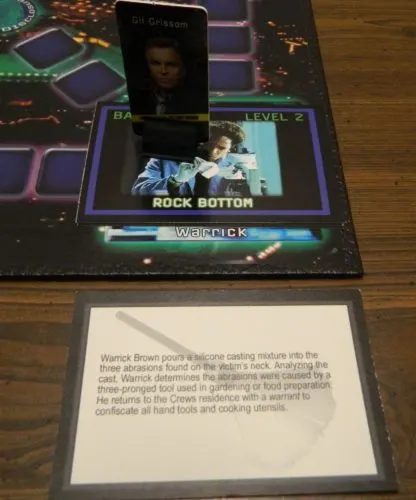
This player landed on the ballistics space so they look at the level one card from the ballistics department.
Grissom: When a player lands on the Grissom space they can move their playing piece to any other crime lab division and read the corresponding clue. If you are the first player to land on the space in level one or two you get to take the corresponding Grissom card. The player has to read part of the card out loud but they get to keep the rest of the card secret.
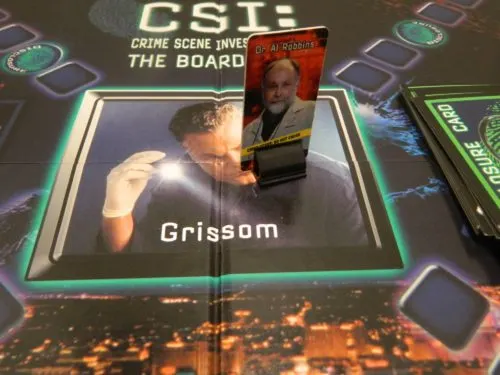
This player landed on the Grissom space. If the Grissom card for their current level is available they can take it. The player can then move their piece to any other department on the board.
Disclosure: When a player lands on a disclosure space they draw the top card from the disclosure deck. The player reads the card and follows its instructions. If the card allows a player to use the card at a later time, the player can choose when they want to use it. Once a disclosure card is used it is returned to the bottom of the disclosure deck.
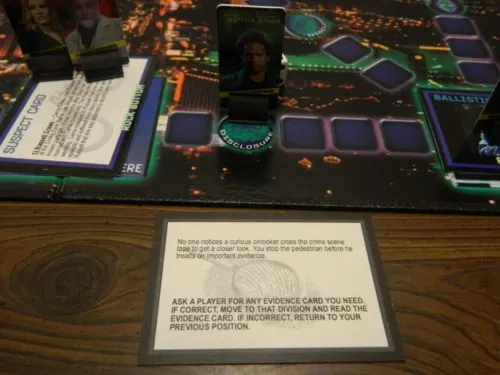
This player has landed on a disclosure space so they draw the top disclosure card and follow its instructions.
Regular Space Occupied by Another Player: If a player lands on a regular space occupied by another player, they get a chance to ask that player for a piece of evidence that they already collected. The player chooses one of the divisions and asks the player if they have already seen that clue for the player’s current level. If the player has already seen that clue, the player that asked gets to move their playing piece to the corresponding space and look at the clue. If the player hasn’t seen the clue, the current player stays on their current space. Instead of asking for a division clue a player can choose to take the Grissom card from the other player on the space.
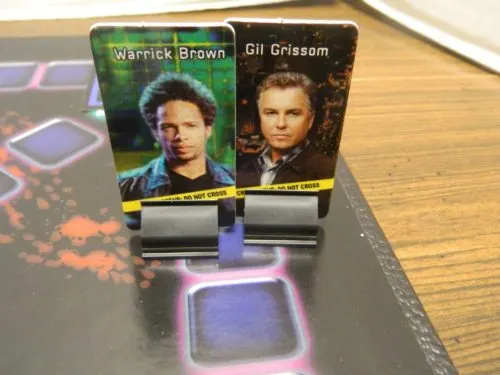
These two players are on the same space. The player who landed on this space second gets to ask the other player whether they have seen a specific clue. If that player has the clue, the player who asked gets to look at the clue as well.
Once a player has acquired all of the clues for level one, they move their piece back to the start space. The player can then read the level two suspect card to themselves. The player will now start collecting level two clues. When a player has collected all of the level two clues they can move onto level three. Once all of the players have completed a level the cards can be turned face up so that they are easier for the players to reference.
Winning the Game
Once a player reaches level three they can continue to collect level three clues or they can try to solve the case. When a player wants to try to solve the case they head towards the Grissom space. When they land on the space by exact count they will submit their arrest warrant. The player fills out their arrest warrant with the suspect’s name, the means (links the cause of death with the suspect), motive (why the suspect killed the victim), and the opportunity (proof that the suspect was at the scene of the crime). In the formal rules the player has to reference a clue (department and level) for the means, motive and opportunity on their checklist without telling the other players. In the informal rules the player reveals their solution to the other players (don’t need specific clues).
The player then reads the solution in the instruction booklet. If the player was correct they read the solution to the other players and they win the game. If the player got one or more of the pieces incorrect, they are eliminated from the game. The rest of the players continue playing the game until someone solves the crime.
My Thoughts on CSI: Crime Scene Investigation The Board Game
When most people think about deduction board games, the first game that comes to their minds is the classic game of Clue. Clue is one of those games that a lot of people either love or hate. Generally I would say that Clue deserves a lot of credit for innovating the deduction genre but it is also far from perfect. Before playing CSI: Crime Scene Investigation The Board Game I was expecting it to basically be Clue with the CSI theme pasted on. While this would have been far from original, it would have been better than what you end up getting in the CSI Board Game.
Playing CSI: Crime Scene Investigation The Board Game kind of feels like you are playing a script of the television show. You roll the dice and move around the board to pick up different parts of the story. This is basically all the game shares in common with Clue. In Clue you use your deduction skills to ask the other players for information which you piece together in order to solve the crime. In CSI: Crime Scene Investigation The Board Game you basically just go to different spaces around the board to read cards which give you more information about the case.
I think the biggest problem with CSI: Crime Scene Investigation The Board Game is that there really isn’t much to the gameplay. You mostly just roll the die and read clues. You try to figure out how the clues work together in order to figure out who the killer is along with the means, motive and opportunity. You can debate how much deduction there really is in Clue but at least you have to be smart when asking questions to the other players. In CSI: Crime Scene Investigation The Board Game the information is just given to you and you just have to figure out how all of the pieces work together. While you still have to figure out what happened, being able to solve the case has more to do with getting all of the key clues instead of actually figuring out anything yourself.
Since there is very little deduction in the game, CSI: Crime Scene Investigation The Board Game ends up as a really dull roll and move game. You roll the die and move around the board. Now this would be boring enough on its own but the game then decides to make it even more excruciating by forcing you to land on spaces by exact count. This adds a lot of luck to the game as you move back and forth hoping to finally roll the number you need to land on one of the spaces you need to get one of the clues. Players will waste quite a few turns going back and forth over a space waiting to finally roll the number they need to visit the space. While eliminating the rule that you have to land exactly on a space would have helped the game (I highly recommend that you do), it still wouldn’t have fixed the many other problems that I had with the game.
When you finally land on one of the spaces and get to look at one of the clues, things don’t get much better. The problem with the clue cards is that each one gives you a pretty long block of text that gives you a bunch of information to sift through. Some of the information is useful and a lot of it is pointless. Since you don’t really know which is which you need to carefully read all of the cards and either write down the key information or try to remember it all. Good luck writing it all down though since the checklist sheets have no room to write down extra information so you need to bring along scratch paper if you want to write down clues you uncover throughout the game. With how much text there is on each card it takes players quite a while to digest it all if they want to get all of the details down. After a while we started letting players complete their turns while the player read their clue cards. This sometimes wasn’t even enough time as the players were sometimes still writing down notes when it got back to their turn.
CSI: Crime Scene Investigation The Board Game really needed to find a way to streamline the game. I don’t mind that the game has some clues that lead nowhere but the game could have done a much better job finding some way to shorten the clues. Instead of large blocks of text that read like a script, the game could have used bullet lists or just one or two sentences instead of a whole paragraph. After a while the reading gets kind of tedious to the point where you start to lose interest in the story.
Speaking of the story it may be the only redeeming quality of CSI: Crime Scene Investigation The Board Game. I will admit that the cases actually have a lot more detail to them than I expected. Instead of a simple _____ killed the person in the _____ with the _____ there is an actual story to each case. While I really haven’t seen a lot of CSI, the case I played actually reminded me a lot of an episode of a TV show. It actually wouldn’t surprise me if the cases from the game were abandoned stories from the show. Fans of the show will probably like the cases quite a bit.
The stories might be somewhat interesting but you then get back to the gameplay. It seems like the designers spent all of their time creating the cases and then forgot to actually build gameplay mechanics to support them. The gameplay feels like breaks between reading the next development in the story. If the game actually had some interesting gameplay mechanics the cases could have made for a pretty good game. With the gameplay lacking so much, you would probably just be better off watching one or two episodes of the show since the stories will be just as interesting and you won’t have to deal with the lackluster gameplay.
If all of this wasn’t enough the game somehow finds a way to mess up the end game. CSI: Crime Scene Investigation The Board Game actually has two ways to end the game and I would highly recommend using the informal method. In the formal method a player has to write down which card directly points to the suspect’s means, motive, and opportunity to commit the crime. Since several clue cards have similar information, good luck guessing which one the designers decided were the key clues that you were supposed to pick. Also good luck actually remembering what card gave you a particularly piece of information unless you write down what card you got each piece of evidence from. I could see you going through the whole game and then no one winning because they didn’t pick the right cards to prove their case. The informal method is much better since you just have to explain the suspect’s means, motive and opportunity and don’t have to remember which cards that information came from. Unless you want to add unnecessary difficulty to the game, I see no reason why you would ever want to use the formal end game rules.
All these problems combine together to create one of the most boring board games that I have ever played which is saying a lot as I have played over 60o different games. The problem is that the lack of actual gameplay and all of the reading leads to the game taking forever. If CSI: Crime Scene Investigation The Board Game was only 30-45 minutes the game would still be bad but it would be bearable. Instead the game usually takes at least an hour and can easily take an hour and a half to two hours. When you get through the first or second level of clues you already wish that the game had ended.
On top of all of these other problems there is the fact you can really only play the game a certain number of times. The problem is that the game only includes eight different mysteries. Once you know the solution to a case the only thing you can do in the game is roll the dice and move around the board collecting the clues you are already familiar with. This will be a really boring experience. To ever enjoy one of the cases again you will have to wait long enough that all of the players forget the solution to the case. The good news is that the game must have actually sold pretty well since the game actually has a lot of expansions/spinoffs. The original CSI has an encore edition and two expansions which contain new cases. The game even has a spinoff for CSI Miami and that game has its’ own expansion so there are plenty of cases if you want to purchase additional versions of the game.
It is not just the lack of cases that hurts CSI: Crime Scene Investigation The Board Game’s components though. The game just feels cheaply made. The game mostly just includes cards, a normal die, playing pieces, and the gameboard. None of these components are of that high of quality. The cards picture images from the show but they are pretty thin and just feature blocks of text. The gameboard is also pretty bland. While the components are good enough to not to be distracting, I wouldn’t consider them to be very good either.
Should You Buy CSI: Crime Scene Investigation The Board Game?
CSI: Crime Scene Investigation The Board Game is simply not a very good game. At first I thought it was going to be Clue with a CSI theme. The only things the game takes from Clue though are its’ worst mechanics. You basically just move around the gameboard collecting clues to eventually solve the case. The stories are actually somewhat interesting but there is nothing to the gameplay. There really isn’t any deduction as you basically just try to find the key clues that lead to the solution. If the game was short these problems might not be as bad but the game feels like it takes forever. Even if you somehow enjoy the game it only comes with eight cases so once you solve them the game has no replay value.
Unless you love the CSI franchise and care more about the story than the actual gameplay, I can’t recommend CSI: Crime Scene Investigation The Board Game. Even if both describe you I would only recommend picking up the game if you can find it really cheap since it has little replay value.
If you would like to purchase CSI: Crime Scene Investigation The Board Game you can find it online: Amazon, eBay

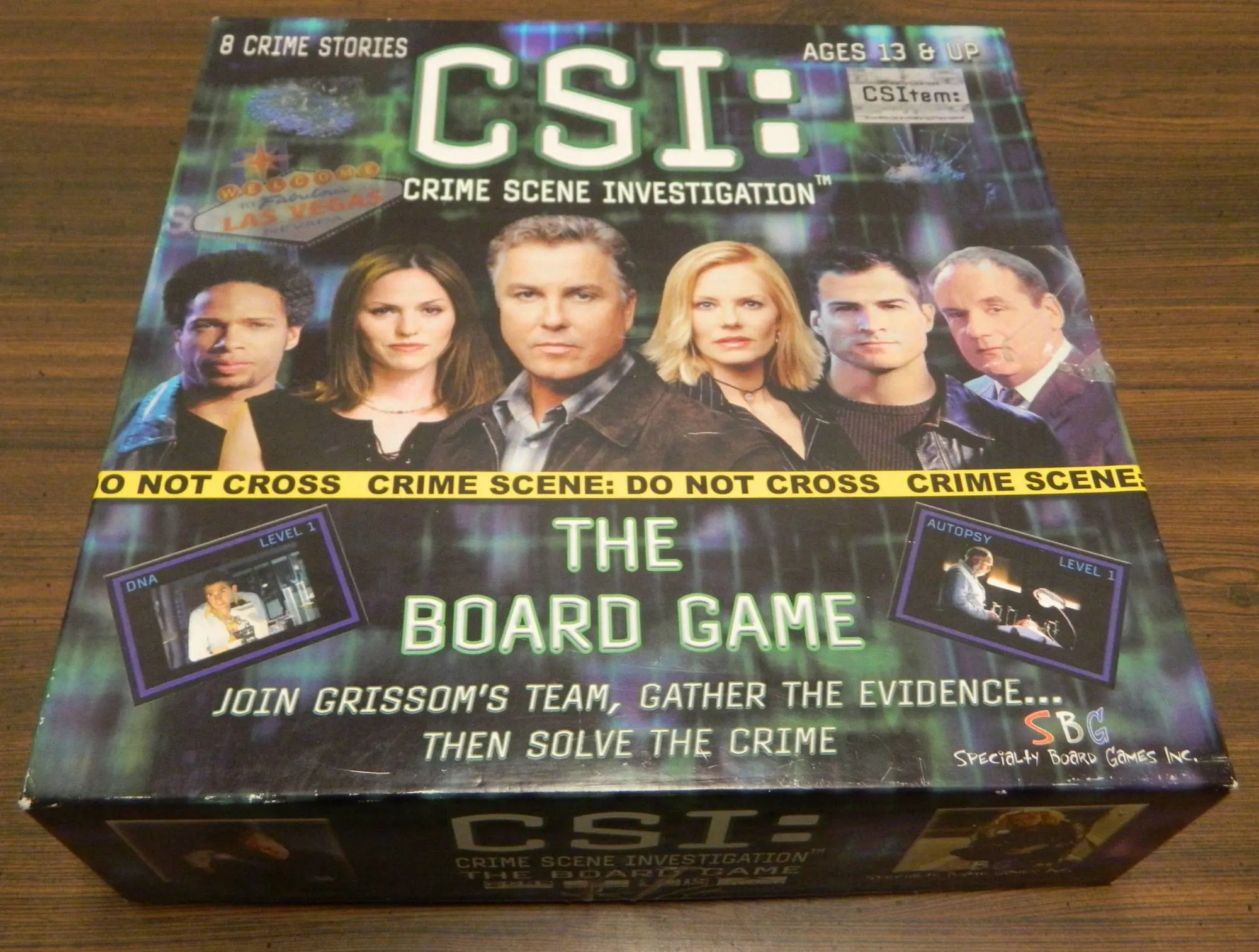
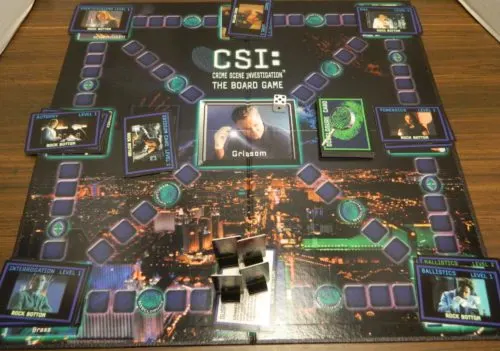
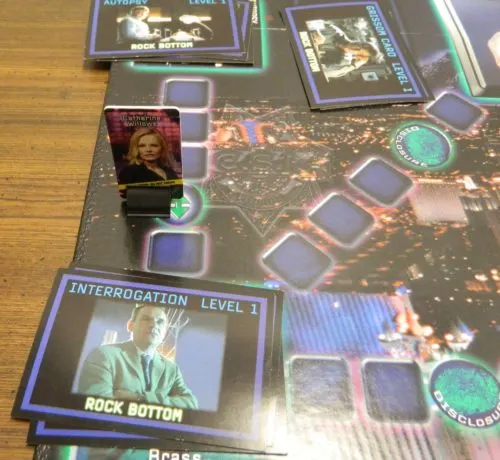
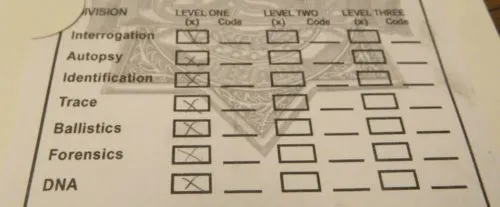
Jennifer Arce Arrieta
Tuesday 19th of May 2020
I´d like to get CSI Senses: The game rules instructions. I got this board game as a gift but rules didn´t come with. I searched them on line but there´s nothing at all. I found others rules related to other CSI game boards. It will be really appreciated CSI Senses The Game Rules appeared (any link to be loaded as a pdf). Tks a lot!!! Greetings from Costa Rica :)
Eric Mortensen
Wednesday 20th of May 2020
Unfortunately I don't know how much I can help you. As I don't own the game I can't provide the instructions.
The only thing I could find online was this review on Board Game Geek which briefly outlines the rules. It doesn't get into specifics though so I am not sure how much it will help you.